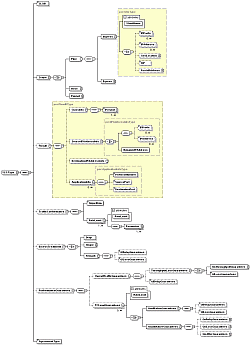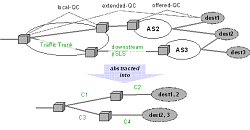The
MESCAL solution to the problem of inter-domain QoS delivery relies
on interactions at the service layer between adjacent providers
for establishing agreements for QoS traffic exchange, pSLSs in MESCAL
terminology, to allow providers to expand the reach of their offered
QoS-based services beyond the boundaries of their domains. Following
the establishment of pSLS, q-BGP message exchanges occur at the
IP layer for finding, establishing and maintaining suitable QoS
routes.
pSLS Management is a layer of the overall MESCAL architecture, per
provider domain, responsible for handling the establishment of pSLSes
(from the perspectives of a single provider domain) and mediating
the information that needs to be exchanged with the TE functions
–mapping service-related to network-related information, intra-
and inter-domain, and vice versa. In particular, it includes the
following aspects, which are regarded as results on their own right.
Service management information model:
An information model representing all notions and entities pertinent
to QoS-based service, pSLS management functionality, also capturing
the outcome of all interactions between the service management layer
and the business and the TE layers has been specified and implemented
in a data-base schema. The model represents entities such as l-QCs,
e-QCs and o-QCs, peer providers and pSLS contents, QC-mappings,
bindings and implementation, inter-domain and intra-domain resources
(from service perspectives), traffic demand matrices and availability
estimates. Based on this model, all pSLS-related functions operate,
proving the validity of the MESCAL specifications.
 Modelling
of pSLSes and QoS-based connectivity services: Suitable
templates -set of parameters with clear semantics- for describing
the contents of c/pSLSes have been specified. MESCAL firmly believes
that there is a need for standardising c/pSLS for the benefit of
Internet service deployment and provisioning; standardised c/pSLSes
would provide a common informational basis for the interactions
between end-customers and providers and between providers, as well
as for building the required service provisioning functionality;
thus, enabling the automation of the respective processes. A two-level
modelling approach was adopted. First, a general, open, detailed
service model for describing pSLS as well as any QoS-based service
was specified. Subsequently, different types of pSLSes, as appropriate
to the various types of business relationships holding between the
providers and the type of QoS to exchange, were specified by appropriately
restricting and/or summarising the information identified in this
open service model. The modelling work has been built on the TEQUILA
SLS template. Modelling
of pSLSes and QoS-based connectivity services: Suitable
templates -set of parameters with clear semantics- for describing
the contents of c/pSLSes have been specified. MESCAL firmly believes
that there is a need for standardising c/pSLS for the benefit of
Internet service deployment and provisioning; standardised c/pSLSes
would provide a common informational basis for the interactions
between end-customers and providers and between providers, as well
as for building the required service provisioning functionality;
thus, enabling the automation of the respective processes. A two-level
modelling approach was adopted. First, a general, open, detailed
service model for describing pSLS as well as any QoS-based service
was specified. Subsequently, different types of pSLSes, as appropriate
to the various types of business relationships holding between the
providers and the type of QoS to exchange, were specified by appropriately
restricting and/or summarising the information identified in this
open service model. The modelling work has been built on the TEQUILA
SLS template.
pSLS validation, mapping and translation:
On their establishment request, pSLSes are validated, mapped and
translated to appropriate network-related information, inter- and
inter-domain, as required for the configuration and the operation
of the lower level service management and TE functions (including
q-BGP), which are responsible for ensuring that pSLS traffic can
access the network and be delivered according to their agreed requirements.
In essence, this work realises the process of provisioning QoS-based
connectivity services, proving the validity of pSLS specifications
and the feasibility of the general MESCAL solution –from pSLSes
to q-BGP configuration.
Demand derivation and aggregation: For
calculating the anticipated traffic demand per QoS class per destination
in the Internet, given a set of pSLSes that a provider domain has
established on request from its peers. The granularity of the traffic
demands per QoS class depends on the granularity of the reachable
destinations in the pSLSes offered by a domain, which for reasons
of scalability and feasibility should be in a coarse/aggregate form.
For a given set of Internet destinations common to a set of pSLSes,
demand derivation and aggregation on behalf of these pSLSes is a
linear function, based on determined multiplexing factors and aggregation
weights per type of traffic. The calculated demands, accordingly
extrapolated, are fed to the off-line TE functions for dimensioning
the network in terms of intra- and inter-domain resources.
 pSLS
admission logic: For determining whether to admit
a requested pSLS or not, perhaps counter-proposing alternative pSLSes,
given the current status of the engineered network to gracefully
sustain new traffic –further subscriptions on QoS traffic. The admission
logic relies on estimates of the availability of the network as
engineered by the TE function to accommodate QoS traffic within
and out from the domain. By formulating an appropriate linear optimisation
problem it determines whether a feasible solution can exist in accommodating
the demand of the newly requested pSLS as well as the demand of
each of the already established pSLSes within the available intra-
and inter-domain resources determined by TE. Clearly, this function,
exerted at pSLS establishment request epochs, constitutes the first
level of control to apply for settling the trade-off between network
utilisation and service agreements at desired levels. The value
of this function should be appreciated taking into account inter-domain
aspects –inter-domain link capacity may not be available as great
as in the core network- also, by considering that pSLSes are agreements,
which if not honoured, negative impact and consequences will be
created. pSLS
admission logic: For determining whether to admit
a requested pSLS or not, perhaps counter-proposing alternative pSLSes,
given the current status of the engineered network to gracefully
sustain new traffic –further subscriptions on QoS traffic. The admission
logic relies on estimates of the availability of the network as
engineered by the TE function to accommodate QoS traffic within
and out from the domain. By formulating an appropriate linear optimisation
problem it determines whether a feasible solution can exist in accommodating
the demand of the newly requested pSLS as well as the demand of
each of the already established pSLSes within the available intra-
and inter-domain resources determined by TE. Clearly, this function,
exerted at pSLS establishment request epochs, constitutes the first
level of control to apply for settling the trade-off between network
utilisation and service agreements at desired levels. The value
of this function should be appreciated taking into account inter-domain
aspects –inter-domain link capacity may not be available as great
as in the core network- also, by considering that pSLSes are agreements,
which if not honoured, negative impact and consequences will be
created.
Evidently, in addition that they were required by the MESCAL inter-domain
QoS delivery solution, the above results automate the process of
service provisioning; highly desired by providers. Their validity
and scalability of the above aspects has been verified through experimentation.
Further
reading:
M.P.
Howarth, P. Flegkas, G. Pavlou, N. Wang, P. Trimintzios, D. Griffin,
J. Griem, M. Boucadair, P. Morand, H. Asgari and P. Georgatsos,
"Provisioning for Inter-domain quality of service: the MESCAL
approach," IEEE Communications Magazine, June 2005. [pdf
document]
MESCAL
deliverable D1.3, "Final specification of protocols and algorithms
for inter-domain SLS management and traffic engineering for QoS-based
IP service delivery", Chapter 9. [link]
MESCAL
deliverable D3.2, "Final
experimental results: validation and performance assessment of algorithms
and protocols for inter-domain QoS through service-driven traffic
engineering",
Chapter 5. [link] |